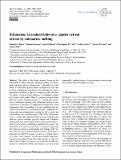Files in this item
Estimating Greenland tidewater glacier retreat driven by submarine melting
Item metadata
| dc.contributor.author | Slater, Donald A. | |
| dc.contributor.author | Straneo, Fiamma | |
| dc.contributor.author | Felikson, Denis | |
| dc.contributor.author | Little, Christopher M. | |
| dc.contributor.author | Goelzer, Heiko | |
| dc.contributor.author | Fettweis, Xavier | |
| dc.contributor.author | Holte, James | |
| dc.date.accessioned | 2020-03-13T11:30:08Z | |
| dc.date.available | 2020-03-13T11:30:08Z | |
| dc.date.issued | 2019-09-26 | |
| dc.identifier | 266866114 | |
| dc.identifier | 97223f0a-683c-4381-8b18-2a770b001370 | |
| dc.identifier | 85072714951 | |
| dc.identifier.citation | Slater , D A , Straneo , F , Felikson , D , Little , C M , Goelzer , H , Fettweis , X & Holte , J 2019 , ' Estimating Greenland tidewater glacier retreat driven by submarine melting ' , Cryosphere , vol. 13 , no. 9 , pp. 2489-2509 . https://doi.org/10.5194/tc-13-2489-2019 | en |
| dc.identifier.issn | 1994-0416 | |
| dc.identifier.other | ORCID: /0000-0001-8394-6149/work/70619154 | |
| dc.identifier.uri | https://hdl.handle.net/10023/19651 | |
| dc.description | This research has been supported by the National Aeronautics and Space Administration, Goddard Space Flight Center (postdoctoral program grant), the National Science Foundation, Office of Polar Programs (grant no. 1513396), the Netherlands Earth System Science Centre (grant no. 024.002.001), the Fonds De La Recherche Scientifique – FNRS (grant no. 2.5020.11),the Fédération Wallonie-Bruxelles (grant no. 1117545), the National Science Foundation, Division of Polar Programs (grant no. 1916566), the National Science Foundation, Office of Polar Programs (grant no. 1756272) and the National Aeronautics and Space Administration (grant no. NNX17AI03G). | en |
| dc.description.abstract | The effect of the North Atlantic Ocean on the Greenland Ice Sheet through submarine melting of Greenland's tidewater glacier calving fronts is thought to be a key driver of widespread glacier retreat, dynamic mass loss and sea level contribution from the ice sheet. Despite its critical importance, problems of process complexity and scale hinder efforts to represent the influence of submarine melting in ice-sheet-scale models. Here we propose parameterizing tidewater glacier terminus position as a simple linear function of submarine melting, with submarine melting in turn estimated as a function of subglacial discharge and ocean temperature. The relationship is tested, calibrated and validated using datasets of terminus position, subglacial discharge and ocean temperature covering the full ice sheet and surrounding ocean from the period 1960–2018. We demonstrate a statistically significant link between multi-decadal tidewater glacier terminus position change and submarine melting and show that the proposed parameterization has predictive power when considering a population of glaciers. An illustrative 21st century projection is considered, suggesting that tidewater glaciers in Greenland will undergo little further retreat in a low-emission RCP2.6 scenario. In contrast, a high-emission RCP8.5 scenario results in a median retreat of 4.2 km, with a quarter of tidewater glaciers experiencing retreat exceeding 10 km. Our study provides a long-term and ice-sheet-wide assessment of the sensitivity of tidewater glaciers to submarine melting and proposes a practical and empirically validated means of incorporating ocean forcing into models of the Greenland ice sheet. | |
| dc.format.extent | 21 | |
| dc.format.extent | 2647771 | |
| dc.language.iso | eng | |
| dc.relation.ispartof | Cryosphere | en |
| dc.subject | GE Environmental Sciences | en |
| dc.subject | Water Science and Technology | en |
| dc.subject | Earth-Surface Processes | en |
| dc.subject | 3rd-DAS | en |
| dc.subject.lcc | GE | en |
| dc.title | Estimating Greenland tidewater glacier retreat driven by submarine melting | en |
| dc.type | Journal article | en |
| dc.contributor.institution | University of St Andrews. School of Geography & Sustainable Development | en |
| dc.identifier.doi | https://doi.org/10.5194/tc-13-2489-2019 | |
| dc.description.status | Peer reviewed | en |
This item appears in the following Collection(s)
Items in the St Andrews Research Repository are protected by copyright, with all rights reserved, unless otherwise indicated.

